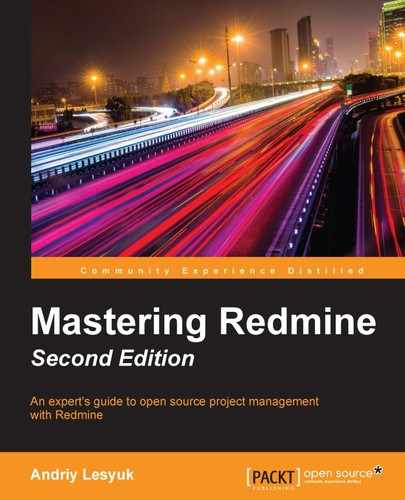Perhaps you have already visited My page—the page that is opened after successful authentication if Redmine fails to redirect you to the previous Redmine page (for example, if you first came right to the login page). You can open this page by clicking on the My page link in the top-left menu. It looks like this:

The idea of this page is to gather all of the information that is interesting to the user in one place so that he/she can quickly move to the page of interest. However, as you already know, there is a lot of information that the user can be interested in. Therefore, this page comes with the Personalize this page link. This link can be used to switch it into edit mode, which is shown in the following screenshot:

In this mode, each block of the personal page can be dragged or removed. To drag a block, you need to press the mouse button when the cursor is above its header, and move the mouse arrow while holding the button pressed (thus, in the preceding screenshot, I'm moving the Latest news block). To remove a block, you need to click on the ![]() icon that can be found in its top-right corner.
icon that can be found in its top-right corner.
The personal page is divided into three sections—the wide top section, the left column section, and the right column section. Each is outlined by dashed lines. You can move blocks between these sections and change the order of blocks inside them. Any of the sections can also be empty.
To add a new block, you can use the My page block drop-down list. Its content is shown in the following screenshot:

So, to add a block, you need to select it in this list and click on the Add link. After this, the block will appear in the wide top section, from where you will be able to move it to another section. Also note that you can add any of the listed blocks to your personal page only once.
The Back link should be used to switch the personal page into the normal non-editable mode.
Now let's review what information these blocks provide.
The Issues assigned to me block contains the list of issues that are assigned to you. It looks like the following screenshot:

This list is limited to 10 items. However, the Issues assigned to me link (the header) can be used to go to the issue list with the issue filter set to the appropriate values, which will make the issue list include all such issues. The issues in this block are ordered by their priority and last update time. Also, the right mouse button can be used to invoke the issue contextual menu, which should already be familiar to you.
The Reported issues block contains issues that were created by you. In fact, this is the only place where you can quickly find such issues. Therefore, I personally use this block quite often (you can also use a custom query to list such issues, though).

The issues in this block are ordered by their update time. As with the previous block, you can use the right mouse button to invoke the contextual menu for selected issues (hold Ctrl to select several issues). The header of the block is a link that points to the issue list that will include all issues reported by you.
The Watched issues block is another issue list.

This block lists issues that are watched by you. They are sorted by their update time. The block also supports the contextual menu and its header is also a link to the full issue list.
The Latest news block contains the 10 latest news items from projects that you are a member of. It looks like in this screenshot:

The Calendar block is your personal calendar for the current week.

Like the Calendar tab of a project, this block contains important events on projects that you are a member of.
The Documents block lists up to 10 documents from projects that you are a member of. It looks like this:

This list contains recently added documents.
If you want to use Redmine for time tracking, you may find the Spent time block useful.

This block lists your time entries for the last seven days. As you can see, here they can be modified and removed. Also, here you can add new time entries using the Log time link. Moreover, clicking on the Spent time link (the header) opens the time report with the filter set to show only your time logs.
